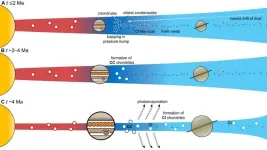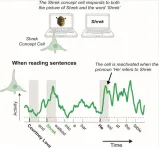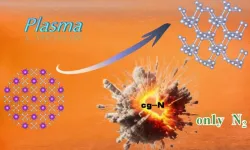(Press-News.org) University of Cincinnati Cancer Center experts will present research at the American Society for Radiation Oncology (ASTRO) Annual Meeting Sept. 29 through Oct. 2.
Osteoradionecrosis more common in patients with head and neck cancer that requires partial jaw removal
Following radiation treatment for head and neck cancer, some patients can experience osteoradionecrosis (ORN) when an area of exposed bone fails to heal after a three-month period.
“ORN of the mandible and maxilla (jaw bones) can be very debilitating, as it often causes severe pain, fistula formation, infection and susceptibility to fractures,” said Alyssa Farley, MD, a third-year resident in the Department of Radiation Oncology in UC’s College of Medicine. “The symptoms directly and indirectly from ORN lead to a significant decrease in quality of life for patients, including severe financial burdens.”
Farley and her colleagues — including Vinita Takiar, MD, PhD, who is principal investigator on the project — looked at contemporary rates for ORN in oral cavity squamous cell carcinoma, a specific type of head and neck cancer.
In this subpopulation, the team found higher rates of ORN than previously reported. Rates of ORN increased as age at diagnosis decreased and when surgical removal of part or all of the mandible or maxilla was part of the treatment plan.
ORN management can range from conservative medications to intense surgical intervention, Farley said. Moving forward, the team plans to study preventative treatments in identified high-risk populations to decrease ORN rates.
Coauthors of the abstract include Takiar, Farley, Nigel Dick and Taylor Petery.
Progesterone contraception a risk factor for visual impairment in patients with meningiomas
Brain or spinal cord tumors called meningiomas can cause visual impairment, which is sometimes severe and permanent, that can be used as a surrogate for analyzing tumor growth.
In theory, the estrogen and progesterone receptors on these meningiomas could help the tumors grow when exposed to higher levels of these hormones. However, a lack of data prevented further understanding of how hormonal contraception affected tumor growth in premenopausal women with meningiomas being referred for radiation.
“We wanted to understand the connection and risk of taking hormonal contraception/supplementation to vision deficits related to meningiomas,” said abstract first author Morgan Bailey, MD, a resident in the Department of Radiation Oncology in UC’s College of Medicine.
The researchers found progesterone — specifically the drug formulation Provera — is a significant risk factor for meningioma-related vision loss in this patient population. They are now performing testing on all patient samples to see how many patients express the progesterone receptor.
“We have contacted women from our study taking these medications to inform them of the risk, many of whom have since stopped taking Provera,” Bailey said. “Our findings highlight the importance of age-appropriate counseling, consistent pathologic assessment of estrogen receptor/progesterone receptor status for meningiomas and a greater awareness of the risk of meningioma-related vision loss amongst neurosurgeons and radiation oncologists.”
Additional coauthors include senior author Kyle Wang, Chase Avery, Luke Pater, Tim Struve, Ralph Vatner, Andrew Frankart, Sarah Sittenfeld, Kevin Shiue, Lalanthica Yogendran, Rekha Chaudhary, Jonathan Forbes, Norberto Andaluz, Matthew Hagen, Ady Kendler, Rocco Rossi and John Breneman.
Radiation and Plk1 inhibitor a potential combination therapy for HPV-negative head and neck cancer
Researchers analyzing patient and clinical trial data have found current frontline treatments for head and neck cancer are insufficient to improve survival outcomes on their own, presenting the need to develop combination therapies that attack cancer cells on multiple fronts.
Cancer Center researchers have focused on a specific gene called Plk1 that, when high, typically correlates with lower survival rates and is known to be overexpressed in many cancers, including head and neck cancers.
“The main research question we were asking was to investigate the role of Plk1 in head and neck cancer patients,” said abstract first author Julianna Korns, a doctoral student working in Takiar and Trisha Wise-Draper’s lab. “We wanted to determine if targeting Plk1 with a highly specific inhibitor, onvansertib, would enhance radiation therapy for head and neck cancer patients.”
Korns explained head and neck cancers can be broken down by human papillomavirus (HPV) status. HPV-negative patients are typically more resistant to therapy than HPV-positive patients.
The team found combining onvansertib with radiation treatment reduced the cell viability and tumor growth of HPV-negative head and neck cancers but did not have the same effect on HPV-positive cancer cells.
“We are currently investigating the mechanistic differences between HPV-negative and HPV-positive head and neck cancers after treatment with onvansertib and radiation,” Korns said. “Overall, we have promising data that points to combining Plk1 inhibition by using onvansertib and radiation in HPV-negative head and neck cancer patients that we hope will translate into clinical trials in this patient population.”
Coauthors of the abstract include Takiar, Korns, Wise-Draper and Maria Lehn.
Cancer Center researchers’ involvement at ASTRO includes:
Teresa Meier, MD, moderating the special session “Developmental Therapies and Quality Assurance in Early Phase Gynecologic Clinical Trials,” Sept. 29 at 8 a.m.
Vinita Takiar, MD, PhD, participating as a mentor in the session “Navigating and Maximizing the Mentor-Mentee Relationship,” Sept. 29 at 3 p.m.
Emily Daugherty, MD, comoderating the session “Exploring the Future of AI, Radiomics and Deep Learning in Radiation Oncology Research,” Sept. 29 at 4:45 p.m.
Sarah Feldkamp, MD, presenting the poster “Treatment Patterns and Outcomes in Geriatric Women with Cervical Cancer,” Sept. 30 at 8 a.m.
Anthony Mascia, PhD, presenting “Proton Flash Trials: Insights from FAST-01 and 02,” Sept. 30 at 10:45 a.m.
Morgan Bailey, MD, presenting the poster “Progesterone Contraception Is Associated with Tumor-Related Visual Impairment in Premenopausal Women with Meningioma Referred for Radiation,” Sept. 30 at 10:45 a.m.
Jonathan Sackett, MD, presenting the poster “Rapid Early Progression After Surgery for IDH-Wildtype Glioblastoma and the Importance of the Pre-Radiation Planning MRI,” Sept. 30 at 10:45 a.m.
Luke Pater, MD, presenting the invited speaker discussion “Current Radiotherapy Approaches for Pediatric Wilms Tumor,” Sept. 30 at 3 p.m.
Julianna Korns, BS, presenting the poster “Combining Plk1 Inhibition and Radiation to Target Head and Neck Cancer,” Sept. 30 at 5 p.m.
Takiar moderating the education session “Prophylactic Feeding Tube Placement in Head and Neck Cancer: Hard to Swallow?” Oct. 1 at 2:30 p.m.
Maddie Schumacher, BS, presenting the poster “Toxicity After Proton Beam Therapy for New and Recurrent Breast Cancer,” Oct. 2 at 8:30 a.m.
Alyssa Farley, MD, presenting the poster “Osteoradionecrosis Incidence in Oral Cavity Squamous Cell Carcinoma,” Oct. 2 at 10:30 a.m. END
Head and neck, meningioma research highlights of University of Cincinnati ASTRO abstracts
Cancer Center researchers to present at national meeting
2024-09-27
ELSE PRESS RELEASES FROM THIS DATE:
Center for BrainHealth receives $2 million match gift from Adm. William McRaven (ret.), recipient of Courage & Civility Award
2024-09-27
Center for BrainHealth® at The University of Texas at Dallas has received a major match gift commitment from retired U.S. Navy four-star admiral and former University of Texas System chancellor William McRaven and his wife Georgeann. Adm. McRaven recently received the 2024 Bezos Courage & Civility Award presented by Amazon founder Jeff Bezos and Lauren Sánchez.
The $2 million challenge grant will support Optimal BrainHealth for Warfighters – including active-duty military, spouses and veterans. This program will help those with traumatic brain injury (TBI), post-traumatic stress (PTS) and similar issues, as well ...
Circadian disruption, gut microbiome changes linked to colorectal cancer progression
2024-09-27
Irvine, Calif., Sept. 27, 2024 — Research from the University of California, Irvine has revealed how disruption of the circadian clock, the body’s internal, 24-hour biological pacemaker, may accelerate the progression of colorectal cancer by affecting the gut microbiome and intestinal barrier function. This discovery offers new avenues for prevention and treatment strategies.
The study, published online today in the journal Science Advances, offers a more comprehensive understanding of how important changes occur in the function and composition of the gut microbiome when the circadian clock is disturbed in the presence ...
Grant helps UT develop support tool for extreme weather events
2024-09-27
The University of Tennessee and the UT Institute of Agriculture have received a $434,038 Seeding Solutions grant from the Foundation for Food & Agriculture Research (FFAR) to develop and test a decision support tool for farmers to better manage crop production from risks of extreme weather events across the Tennessee River Basin and surrounding southeast US regions.
UT is providing matching funds for a total investment of $966,119 over the three-year project.
The U.S. Department of Agriculture estimates that extreme weather is responsible for 90% of crop losses. These estimates are generally based on annual climate conditions. ...
Autonomous vehicles can be imperfect — As long as they’re resilient
2024-09-27
Researchers from three of Virginia’s premier universities, including the University of Virginia’s Homa Alemzadeh, aim to take the risk out of self-driving vehicles by overcoming inevitable computer failures with good engineering.
The trio will share a $926,737 National Science Foundation award to identify when and where autonomous vehicle systems are most vulnerable to safety-critical failures. They plan to use this knowledge to design ways to efficiently mitigate potential safety hazards and enhance the overall system resilience.
Alemzadeh, an associate professor of electrical and computer engineering in UVA’s School of Engineering and Applied ...
Asteroid Ceres is a former ocean world that slowly formed into a giant, murky icy orb
2024-09-27
Since the first sighting of the first-discovered and largest asteroid in our solar system was made in 1801 by Giuseppe Piazzi, astronomers and planetary scientists have pondered the make-up of this asteroid/dwarf planet. Its heavily battered and dimpled surface is covered in impact craters. Scientists have long argued that visible craters on the surface meant that Ceres could not be very icy.
Researchers at Purdue University and the NASA's Jet Propulsion Lab (JPL) now believe Ceres is a very icy ...
McMaster researchers discover what hinders DNA repair in patients with Huntington’s Disease
2024-09-27
Researchers with McMaster University have discovered that the protein mutated in patients with Huntington’s Disease doesn't repair DNA as intended, impacting the ability of brain cells to heal themselves.
The research, published in PNAS on Sept. 27, 2024, found that the huntingtin protein helps create special molecules that are important for fixing DNA damage. These molecules, known as Poly [ADP-ribose] (PAR), gather around damaged DNA and, like a net, pull in all the factors needed for the repair process.
In people with Huntington’s Disease, however, the research found that the mutated version of this protein doesn’t function properly ...
Estrogens play a hidden role in cancers, inhibiting a key immune cell
2024-09-27
DURHAM, N.C. – Estrogens are known to drive tumor growth in breast cancer cells that carry its receptors, but a new study by Duke Cancer Institute researchers unexpectedly finds that estrogens play a role in fueling the growth of breast cancers without the receptors, as well as numerous other cancers.
Appearing Sept. 27 in the journal Science Advances, the researchers describe how estrogens not only decrease the ability of the immune system to attack tumors, but also reduce the effectiveness of immunotherapies that are used to treat many cancers, notably triple-negative breast cancers. Triple-negative ...
A new birthplace for asteroid Ryugu
2024-09-27
In December 2020 the space probe Hayabusa 2 brought samples of asteroid Ryugu back to Earth. Since then, the few grams of material have been through quite a lot. After initial examinations in Japan, some of the tiny, jet-black grains traveled to research facilities around the world. There they were measured, weighed, chemically analyzed and exposed to infrared, X-ray and synchroton radiation, among other things. At the MPS, researchers examine the ratios of certain metal isotopes in the samples, as in the current study. Scientists refer to isotopes as variants of the same element that differ only in the number of neutrons in the nucleus. Investigations ...
How are pronouns processed in the memory-region of our brain?
2024-09-27
A new study shows how individual brain cells in the hippocampus respond to pronouns. “This may help us unravel how we remember what we read.”
Read the following sentence: “Donald Trump and Kamala Harris walked into the bar, she sat down at a table.” We all immediately know that it was Kamala who sat at the table, not Donald. Pronouns like “she” help us to understand language, but pronouns can have multiple meanings. Depending on the context, we understand who the pronoun is referring to. But ...
Researchers synthesize high-energy-density cubic gauche nitrogen at atmospheric pressure
2024-09-27
Recently, a research group led by Prof. WANG Xianlong from the Hefei Institutes of Physical Science of the Chinese Academy of Sciences, successfully synthesized high-energy-density materials cubic gauche nitrogen (cg-N) at atmospheric pressure by treating potassium azide (KN3) using the plasma-enhanced chemical vapour deposition technique (PECVD).
The research results were published in Science Advances.
Cg-N is a pure nitrogen material consisting of nitrogen atoms bonded by N-N single bonds, resembling the structure of diamond. It has attracted attention because it has a high-energy-density and produces only nitrogen gas when it decomposes. ...
LAST 30 PRESS RELEASES:
Injectable breast ‘implant’ offers alternative to traditional surgeries
Neuroscientists devise formulas to measure multilingualism
New prostate cancer trial seeks to reduce toxicity without sacrificing efficacy
Geometry shapes life
A CRISPR screen reveals many previously unrecognized genes required for brain development and a new neurodevelopmental disorder
Hot flush treatment has anti-breast cancer activity, study finds
Securing AI systems against growing cybersecurity threats
Longest observation of an active solar region
Why nail-biting, procrastination and other self-sabotaging behaviors are rooted in survival instincts
Regional variations in mechanical properties of porcine leptomeninges
Artificial empathy in therapy and healthcare: advancements in interpersonal interaction technologies
Why some brains switch gears more efficiently than others
UVA’s Jundong Li wins ICDM’S 2025 Tao Li Award for data mining, machine learning
UVA’s low-power, high-performance computer power player Mircea Stan earns National Academy of Inventors fellowship
Not playing by the rules: USU researcher explores filamentous algae dynamics in rivers
Do our body clocks influence our risk of dementia?
Anthropologists offer new evidence of bipedalism in long-debated fossil discovery
Safer receipt paper from wood
Dosage-sensitive genes suggest no whole-genome duplications in ancestral angiosperm
First ancient human herpesvirus genomes document their deep history with humans
Why Some Bacteria Survive Antibiotics and How to Stop Them - New study reveals that bacteria can survive antibiotic treatment through two fundamentally different “shutdown modes”
UCLA study links scar healing to dangerous placenta condition
CHANGE-seq-BE finds off-target changes in the genome from base editors
The Journal of Nuclear Medicine Ahead-of-Print Tip Sheet: January 2, 2026
Delayed or absent first dose of measles, mumps, and rubella vaccination
Trends in US preterm birth rates by household income and race and ethnicity
Study identifies potential biomarker linked to progression and brain inflammation in multiple sclerosis
Many mothers in Norway do not show up for postnatal check-ups
Researchers want to find out why quick clay is so unstable
Superradiant spins show teamwork at the quantum scale
[Press-News.org] Head and neck, meningioma research highlights of University of Cincinnati ASTRO abstractsCancer Center researchers to present at national meeting





